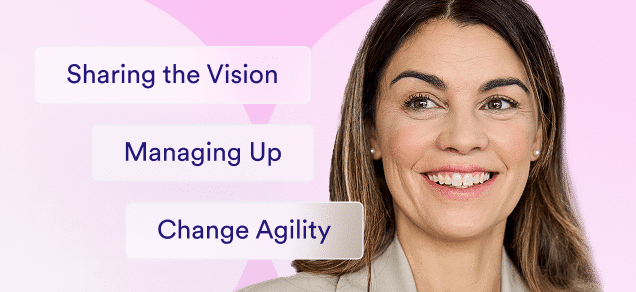The ability to effectively navigate and adapt to change has become more crucial than ever. This is where change management steps in, acting as a strategic framework that facilitates smooth transitions and ensures that organizational goals are not only achieved but surpassed. By proactively managing change, organizations can thrive in ever-changing environments, enhance performance, and maintain a competitive edge. But more than 70% of change programs fail to achieve their goals — and one of the biggest reasons is a lack of support from management. Let’s explore the significance of organizational change and some of the core responsibilities of change management for leaders.
The 5 Essential Responsibilities of Change Management for Leaders
1. Communicating the Need for Change
One critical aspect of change management for leaders is communicating the need for change and its associated benefits to stakeholders. Clear and compelling communication catalyzes building support and minimizing resistance to change initiatives.
When leaders effectively communicate the need for change, they create a sense of urgency and understanding among stakeholders. By articulating the reasons behind the change, leaders can help stakeholders recognize the importance of embracing new ways of doing things. They can paint a vivid picture of the future state, highlighting the positive impact the change will have on the organization, its employees, customers, and other key stakeholders.
A recent work communication Gallup survey found that employees who strongly agree that their leaders help them see how changes made today will affect their organization in the future are significantly more likely to also strongly agree that their company has the speed and agility to meet customer and marketplace change and that they know what’s expected of them.
Effective communication is instrumental in addressing resistance to change. Change often triggers uncertainty and apprehension among employees and other stakeholders. Leaders must proactively address concerns and doubts by openly acknowledging resistance and providing relevant information and reassurance. Transparent communication helps dispel rumors and misconceptions, fostering a culture of trust and openness.
Leaders should create platforms for two-way communication, allowing stakeholders to voice their opinions, concerns, and ideas. Actively listening to feedback and engaging in meaningful dialogue demonstrates that leaders value the perspectives of those affected by the change. This inclusive approach helps identify potential obstacles and resistance points and increases stakeholder ownership and buy-in.
By effectively communicating the need for change and its benefits, leaders can generate enthusiasm and support for change initiatives. Stakeholders become more likely to embrace the change and actively contribute to its successful implementation. Open and honest communication throughout the change process enables leaders to make adjustments, address challenges, and maintain momentum, thereby increasing the likelihood of achieving the desired outcomes.
How do we embrace change? Many times it comes down to how we feel inspired. Leaders should learn to understand how people react to their change communication style and identify what behaviors drive others’ responses to their change efforts. From there, they can make adjustments to lead through each phase of change: resistance, compliance, and commitment.
2. Developing a Clear Vision and Strategy
Another critical step in change management for leaders is to create a well-defined vision and strategy. This serves as a roadmap for change, guiding the organization through the new process and aligning resources effectively. It also helps build support for change initiatives by providing a clear direction and rationale for the proposed changes. A vision statement outlines the organization’s desired future state and communicates the change’s purpose and value. It should be concise, inspiring, and easily understood by all stakeholders.
Vision Statement Example
To become the industry leader in leveraging advanced technologies to streamline operations, enhance product quality, and exceed customer expectations.
In addition, a well-crafted strategy document outlines the specific steps, actions, and timelines required to achieve the vision. It should include the objectives, key milestones, and measurable goals associated with the change initiative.
Additionally, the strategy should address potential challenges, risks, and mitigation plans. For instance, a strategy document for implementing a new customer relationship management (CRM) system might include milestones such as “Complete CRM vendor evaluation and selection process by Q2” or “Train employees on CRM usage by Q4.”
These documents help align resources by providing a clear decision-making framework and allocation framework. Leaders can identify and allocate financial, human, and technological resources to support the change initiative. By articulating the expected outcomes and benefits, the vision and strategy document enable leaders to secure the necessary support and investment from key stakeholders, such as senior executives, board members, and employees.
The vision and strategy documents serve as communication tools to build support for change initiatives. Leaders can leverage their power skills to present the vision and strategy compellingly. By demonstrating a deep understanding of the organization’s current state, challenges, and opportunities, leaders can connect with stakeholders emotionally and inspire them to embrace the change.
3. Stakeholder Engagement
Implementing change successfully requires more than just a well-designed plan; it demands stakeholders’ active involvement and support. Stakeholder engagement plays a vital role in change management, enabling leaders to harness the collective wisdom and commitment of those affected by the change.
Stakeholders possess unique insights and perspectives that can significantly influence the success of change initiatives. According to a McKinsey study, organizations involving stakeholders in decision-making processes are 3.5 times more likely to outperform their peers in implementing successful change projects. Engaging stakeholders ensures that diverse viewpoints inform decisions and enable leaders to make better choices.
From the start, engaging leaders, managers, and individual contributors cultivate a sense of ownership and empowerment. This community involvement fosters a shared understanding of the need for change and creates a supportive environment where stakeholders actively contribute to the change initiative.
Leaders can harness their collective intelligence, mitigate resistance, and drive successful change initiatives by actively involving stakeholders. As organizations navigate an ever-changing business landscape, stakeholder engagement will continue to be the linchpin for sustainable growth, adaptability, and success.
Building a sustainable model with well-defined roles for each individual helps build affinity and action toward change. Leaders can start by communicating the 5 D’s of Change with stakeholders. Leaders and contributors understand how to enact and support change with this mix.
5 D’s of Change
- Define – ask the right questions
- Discover – focus on your organization’s strengths
- Dream – envision possible future states
- Design – articulate your plan to achieve change
- Deliver – execute your change plan
4. Aligning Resources and Building Support
Leaders need to assess and allocate resources strategically to support the implementation of change. Allocating resources in alignment with the change objectives helps optimize efficiency, ensuring that the necessary tools, technology, and personnel are available to facilitate the change process.
By providing the necessary resources, leaders can alleviate concerns and foster a positive environment for change. This helps address one of the common reasons for resistance to change—fears related to workload, capacity, and competence.
Building support for change within each team enhances adaptability. When leaders can structure each change initiative, organizations can be agile and adaptable. This supports employees to respond promptly to unforeseen challenges, seize opportunities, and adjust course as needed.
Sustainable momentum is an essential element of a successful change management process. Actively involving stakeholders throughout the change initiative helps raise commitment and drives participation. By keeping stakeholders informed and engaged, leaders can maintain focus and enthusiasm, ensuring the change effort does not lose steam over time.
Timeline of Change Management for Leaders
Phase 1: Planning and Preparation
This phase involves defining the objectives, creating a change management plan, and identifying potential challenges and risks. It sets the foundation for the entire change management process.
- Clearly articulate the vision and goals of the change to inspire and align stakeholders.
- Conduct a thorough analysis of the organization’s current state and readiness for change.
- Identify and involve key stakeholders early on to gain their support and insights.
- Develop a comprehensive change management plan that outlines the strategies, tactics, and timeline for implementation.
Phase 2: Communication and Engagement
Communication and engagement are crucial to inform and involve stakeholders throughout the change process. It helps create awareness, build support, and manage resistance.
- Develop a robust communication strategy that includes both top-down and bottom-up communication channels.
- Tailor the messaging to different stakeholder groups and address their concerns and interests.
- Encourage two-way communication by actively listening to feedback and addressing questions and concerns.
- Provide regular updates on the progress of the change initiative to keep stakeholders informed and engaged.
Phase 3: Implementation
This phase involves executing the change plan, implementing new processes, systems, or structures, and managing the transition from the current state to the desired state.
- Provide clear guidance and support to employees during the transition, ensuring they understand their roles and responsibilities.
- Monitor progress and address any implementation challenges promptly to minimize disruption and resistance.
- Foster a culture of flexibility and adaptability to navigate unforeseen obstacles.
- Celebrate small wins and recognize the efforts of individuals and teams to maintain motivation and momentum.
Phase 4: Evaluation and Adjustment
Evaluation allows leaders to assess the change initiative’s success, identify improvement areas, and make necessary adjustments for long-term sustainability.
- Establish key performance indicators (KPIs) to measure the impact and effectiveness of the change.
- Collect feedback from stakeholders, employees, and other relevant parties to gain insights and identify gaps.
- Analyze the data and evaluate the outcomes against the initial objectives and expected benefits.
- Use the evaluation results to refine the change management approach, address any remaining resistance, and reinforce successful practices.
Leading by Example and Modeling Desired Behaviors:
One of the key responsibilities in change management for leaders is to model the desired behaviors that support and reinforce the change. By leading through example, leaders can build trust, inspire others, and create a positive environment that encourages individuals to embrace and adopt the change.
Through their actions, leaders set the tone, create a positive example, and foster a culture that supports the change vision. Organizations can navigate change more effectively by prioritizing these leadership behaviors, achieving better employee engagement, and driving successful outcomes.
Leadership in change management is not just about directing and managing change; it is about embodying the change and inspiring others to join the journey toward a better future.
“The ageless essence of leadership is to create an alignment of strengths in ways that make a system’s weaknesses irrelevant” – Peter Drucker, bestselling author and worldwide leader in management
Here are four critical factors in effective leadership modeling:
- Transparent communication,
- Openness to feedback,
- Adaptability and resilience
- Support and empowerment.
Transparent communication is a critical behavior that leaders should model during change. By openly sharing information, leaders create a sense of transparency, which helps to build trust and reduce uncertainty.
Leaders who are open to feedback create an environment encouraging individuals to share their thoughts and ideas about the change. By actively seeking and valuing input, leaders are willing to listen and consider alternative perspectives.
Change often brings unforeseen challenges and obstacles. Leaders who model adaptability and resilience inspire others to embrace change as an opportunity for growth. When leaders demonstrate adaptability and strength, it instills confidence in others, motivates them to overcome obstacles, and reinforces the belief that change is manageable and worthwhile.
Leaders who model support and empowerment create an environment where individuals feel valued and capable of contributing to the change process. When leaders demonstrate support and empowerment, it boosts employee morale, fosters a sense of ownership, and creates a culture of collaboration and commitment.
Monitoring and Measuring the Impact of Change
Change initiatives are driven by the need for organizations to adapt, improve, and thrive in dynamic environments. Effective leadership in monitoring and measuring the impact of change on organizational performance is crucial for ensuring that change efforts achieve their desired outcomes.
By implementing robust monitoring and measurement practices, leaders can gain valuable insights, identify areas for improvement, and make informed decisions to adjust course and maximize the change initiative’s success.
Tracking Progress and Milestones
Monitoring and measuring the progress of a change initiative helps leaders stay on track and assess whether the desired outcomes are being achieved. It provides a means to identify early warning signs, potential bottlenecks, and areas requiring intervention.
Assessing Impact on Performance
Measuring the impact of change on organizational performance is essential to understand the effectiveness of the change initiative and its contribution to desired outcomes. By evaluating the impact of change on performance, leaders can gain insights into the effectiveness of the change efforts, identify areas of success, and pinpoint areas that require further attention or adjustment.
Making Informed Decisions and Adjustments
Effective monitoring and measurement provide leaders with the information needed to make informed decisions and adjustments to the change initiative. Making data-driven decisions and adjustments enables leaders to optimize the change process, address emerging challenges, and increase the likelihood of achieving the desired outcomes.
Effective monitoring and measurement are not isolated activities but ongoing process that requires continuous evaluation, data analysis, and informed decision-making. By embracing this role, leaders become catalysts for positive change and enable their organizations to adapt, grow, and thrive in dynamic environments.
Creating a Leadership in Change Management Development Plan
Leadership development equips leaders with the skills, knowledge, and capabilities to manage change effectively. A well-designed leadership development plan provides a roadmap for leadership in change management to enhance their abilities and navigate the complexities of change.
Effective leadership development plans begin with setting specific goals aligning with the desired skills and competencies to manage change. These goals should be tailored to the leader’s unique context and development areas. Setting particular goals enables leaders to focus their development efforts and provides a clear direction for their growth as change leaders.
Goal Examples:
- Enhancing communication and stakeholder engagement skills to build support for change initiatives
- Developing resilience and adaptability to navigate challenges and uncertainties during the change process
- Strengthening strategic thinking and decision-making abilities to align change efforts with organizational goals
Feedback mechanisms are essential for leadership in change management to gain insights into their strengths and areas for improvement. They provide valuable information on the leader’s performance and help shape their development. Feedback mechanisms enable leaders to gain self-awareness, identify growth areas, and track development progress as change managers.
Types of Feedback Mechanisms:
- 360-degree feedback assessments that collect input from superiors, peers, subordinates, and other stakeholders
- Regular performance evaluations that include discussions on change management competencies
- Coaching and mentoring relationships that provide ongoing feedback and guidance
Sustainable leadership development requires ongoing support to reinforce new skills and knowledge. This support can take various forms and should be integrated into the development plan. Continued support ensures leaders have the necessary resources, guidance, and encouragement to apply their learning in real-world change scenarios.
Ongoing Support Activities and Priorities
- Training programs, workshops, or seminars focused on change management principles, methodologies, and best practices.
- Access relevant resources like books, articles, case studies, and online learning platforms.
- Peer learning and networking opportunities to share experiences and exchange ideas with other change leaders.
- Executive coaching to provide personalized guidance and support throughout the development journey.
Examples of Effective Leadership Development Plans
Plan 1
Goal: Enhance communication and stakeholder engagement skills.
Feedback Mechanisms: 360-degree feedback assessments and regular check-ins with a mentor or coach.
Ongoing Support: Communication workshops, practice sessions, peer feedback circles.
Plan 2
Goal: Develop strategic thinking and decision-making abilities.
Feedback Mechanisms: Performance evaluations, peer feedback, and self-assessment tools.
Ongoing Support: Strategy development workshops, exposure to strategic planning processes, executive coaching.
Plan 3
Goal: Strengthen resilience and adaptability.
Feedback Mechanisms: Coaching sessions focused on resilience and self-reflection exercises.
Ongoing Support: Resilience training, stress management workshops, and access to relevant resilience resources.
4 Benefits of Leadership Development Plans
- Enhanced Change Management Skills: Leadership development plans provide leaders with the specific skills, knowledge, and tools needed to manage change effectively
- Targeted Growth: The focus on specific goals allows leaders to concentrate their efforts on areas critical to change management success
- Continuous Improvement: Feedback mechanisms and ongoing support enable leaders to identify development areas and continually refine their skills
- Increased Confidence: A well-designed leadership development plan boosts leaders’ confidence in navigating change, leading to improved decision-making and problem-solving abilities
Effective Change Management for Leaders
Leaders provide the necessary direction and guidance to navigate the complexities of change, ensuring that the organization stays focused on its goals and objectives. They are responsible for setting a clear vision for the change initiative, outlining the desired outcomes, and communicating them effectively to stakeholders. Leaders play a crucial role in building support and buy-in from employees and stakeholders by actively engaging and involving them throughout the process.
Check out our Leadership Webinars for great tips and insights for managers and key stakeholders in the change management process.













